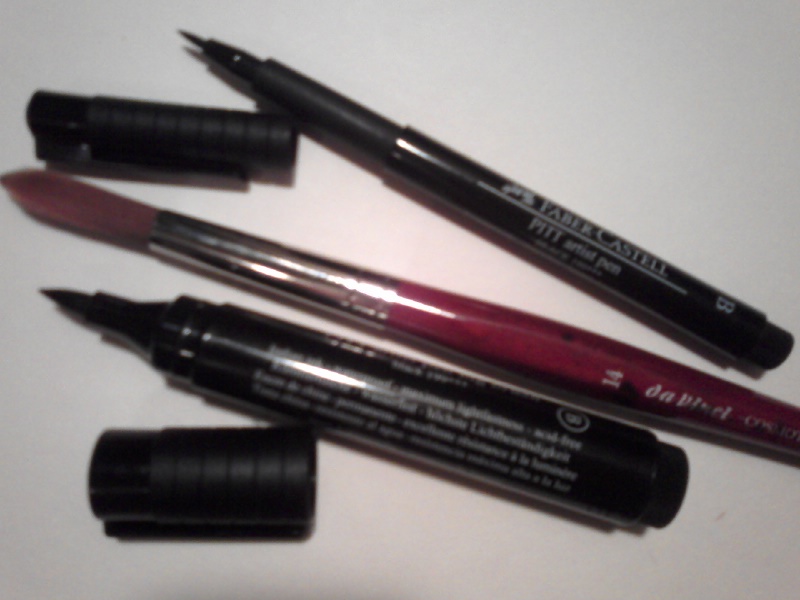Added 1 new A* page:My scanner came today! (Two days with free "super saver" shipping, not bad!) It is a Mustek Scan Express A3 1200 Pro USB Large Format Scanner, and I chose it because I wanted something to scan 11x17 pieces of paper (although it really seems to max at something more like 10.5x16.3", but oh well I guess they always crib with the "margins," don't they :p), and it was more or less the only large-format scanner I could find on Amazon that wasn't ridiculously expensive. It scans at 1200 dpi (I guess they have a newer model that does 2400 dpi, which was about $75 more on Amazon; 1200 dpi is almost more than my computer is comfortable with as it is, though, so I think I'm just as well holding there), and yields incredible results compared with the huge and awful small-format 300 dpi scanner I had ages ago. And it's way less noisy! It takes a while to scan a page at 1200 dpi, but man, that's a lot of pixels.
Oh and the non-driver software it comes with is horrible (for instance, the updated driver package for Windows XP that I downloaded from their site couldn't even handle extracting and installing itself--I had to find the self-extracted files in the Windows/temp folder it had made (before hanging) and run them manually). Fortunately, the actual TWAIN driver and interface for it is pretty good. I was also kind of amused that for a scanning package, they just basically have you download the freeware image utility IrfanView, since it has a TWAIN import function that launches the scanning interface. IrfanView is a mighty fine program, and in fact it's what I use to resize A* pages for uploading to the web!
So anyway I was able to make a nice grayscale scan of that brush pen and marker sketch I showed a crummy photo of yesterday:

The scanner picks up a lot of surface detail from this old sketch pad paper! I'll eventually switch to a smooth Bristol paper; it will be interesting to see how that scans--if it still picks up a lot of surface noise from it I'll have to try messing with a despeckle filter or something, maybe.
Anyway so as I said yesterday, that sketch was done with gray Copic markers for shading, and Faber-Castell "Pitt artist pens," specifically the ones with the "brush" nibs, which I tried to take a photo of with my dumbphone:

That paint brush in there is a synthetic watercolor brush; the clerk at the local Daniel Smith art supply superstore said it was one of the "better" synthetic brushes, meaning that it holds water and pigment well and distributes them evenly, rather than just shooting everything out onto the paper the moment you touch it; the real nice brushes that aren't supposed to have that problem at all are made from animal hairs, but they are also way more expensive. ;_; So I got four of these "da Vinci" synthetic ones at various sizes, but they still do drop too much fluid all at once, leaving you with an initial puddle followed by a dried, scuffed line; some of them even sort of skip off the paper entirely if you try flexing them down in a particular way. Blah.
The big one is okay for filling large spaces, but I'm going to have to go back to the store and pony up the $30 or so for that apparent Holy Grail of inking brushes, the Winsor & Newton Series 7 Kolinsky Sable Brush, size 3, the official brush of Queen Victoria or something. I learned about it from this video of Doug TenNapel talking about his inking; TenNapel has a copious inking style, which you can see in his recently completed Ratfist comic. But apparently that brush has also been the favorite of many print comic artists.
I'm just hoping I'll be able to make nice lines with it, since I couldn't really with the synthetic brushes. So after a bunch of awful brush sketches which are too horrible to show you, I went back to using the large Pitt brush pen for lines, but something else for most of the shading:

So in that one ^, except for the back of the neck, the interior of the ear, and that patch in the upper right, the grays--and the big messy black mass on the right side, for that matter--are ink wash, which is basically water mixed into India ink, which is basically water and lampblack, which is soot, which is carbon. Whew! I haven't looked into it too heavily, but "India ink" appears to be a contested title and implied attribution; people in China were using black ink derived from soot back in the third millennium BC, whereas in India it only goes back to the fourth century or so BC. I suspect we have the British to blame for the name of it (although apparently they call it "Indian ink"; I wonder if non-native Americans felt that would give too much credit to Native Americans or something ;P); the translation of the name on the huge bottle I got renders it as more or less "Chinese Ink" in Spanish and French. Hm!
The Pitt pens also use India ink, so they seem to work pretty well in conjunction with the wash.
|
